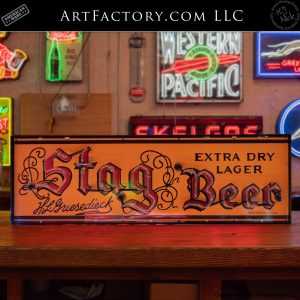When Holes Were Drilled Into A Porcelain Or Tin Sign For Neon Application Does Not Effect Its Value
 Many sign collectors have concern that who, where, or specifically when, the hole were drilled into a sign for neon application will affect the value. However, the key reason that this not the case is because in the Early 20th century, neon signs were rarely, if ever mass produced. At this point in history, many area of the country did not have access to the type of electrical capability that would allow them the to keep a large, outdoor neon sign lit; thus meaning that overwhelmingly, unlit porcelain and tin litho advertisements were what most companies used at this time.
Many sign collectors have concern that who, where, or specifically when, the hole were drilled into a sign for neon application will affect the value. However, the key reason that this not the case is because in the Early 20th century, neon signs were rarely, if ever mass produced. At this point in history, many area of the country did not have access to the type of electrical capability that would allow them the to keep a large, outdoor neon sign lit; thus meaning that overwhelmingly, unlit porcelain and tin litho advertisements were what most companies used at this time.
Companies would order hundreds of porcelain, and or tin litho signs to be used as needed. These signs were generally expected to become junk, and discarded when they were no longer needed, and were never intended to become someone’s collectible. When a neon sign was needed, the sign company would build a housing can, drill holes in a sign they already had in inventory, and glass neon tubes would be hand blown and bent to specifications and installed on the sign. Due to the nature of this process, it is not relevant whether or not the holes for neon application were drilled before, or after that application of paint or porcelain enamel to the sign. It also does not affect the value or, or make the sign any more, or less collectible if the holes were drilled at a later date.
In this example of a Stag Beer Neon Bar Sign, the oversized holes were drilled prior to the paint application. The neon glass hole protector has a large flange that covers this hole edge, and Insulates to prevent the metal sign from causing electrical interference.
